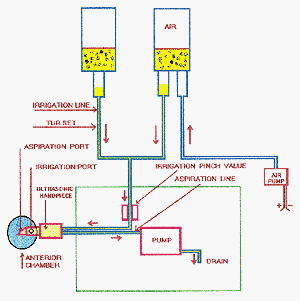Using an air pump during phaco prevents fluid surge
It also helps to prevent posterior capsular rupture and to deepen the anterior chamber.
One of the main difficulties of the phacoemulsification technique is dealing with surge.
Surge occurs when a nuclear fragment occludes the phaco tip under high vacuum and is then abruptly aspirated with a burst of ultrasound. Fluid from the anterior chamber rushes into the phaco tip, which leads to collapse of the anterior chamber.
Surgeons and manufacturers have proposed various methods to solve this problem. Some phaco machines have been devised to address the problem.
Some surgeons have described the use of an anterior chamber maintainer to get more fluid into the eye. The problem with the anterior chamber maintainer is that another port has to be made. If you are doing a case under topical or no anesthesia, as we do in our hospital, three ports can become quite cumbersome.
Another method to solve surge is to use more phacoaspiration and chop the nuclear pieces with the non-dominant hand. The problem with this method is that surgical time increases. If the case is a hard brown cataract, phacoaspiration will not suffice.
Dr. Sunita Agarwal conceived of a method to solve surge using an air pump. The idea occurred to us as we were operating cases with our Phakonit technique, in which a cataract is removed through a 0.9-mm opening. We wanted more fluid entering the eye. Now we routinely use the air pump to solve the problem of surge.
Technique
 ---The air pump and two infusion bottles are connected to a urologic TUR set.
---The air pump and two infusion bottles are connected to a urologic TUR set.
We use two balanced salt solution bottles, not one. These are put in the intravenous (IV) stand.
Instead of using an IV set to take the fluid from the bottle to the phaco handpiece, we use a transurethral (TUR) tubing set, such as is used by urologists. The advantage of the TUR is that the bore of the tubing is quite large, so more fluid passes from the infusion bottle to the phaco handpiece. The TUR set has two tubes that go into two infusion bottles; the two become one, which then passes into the phaco handpiece.
We use a standard air pump that is used in fish tanks to supply oxygen. An IV set connects the air pump to the infusion bottle. The tubing is passed from the air pump into one of the infusion bottles.
When the air pump is switched on, it pumps air into the infusion bottle. The air goes to the top of the bottle, and the pressure pumps the fluid down with greater force. The fluid flows from the infusion bottle into the TUR set to reach the phaco handpiece. The amount of fluid coming out of the handpiece is much greater than would normally come out, and with greater force. The extra amount of fluid coming out compensates for the surge that would otherwise occur.
An air filter can be used between the air pump and the infusion bottle so that the air being pumped into the bottle is sterile.
Before we enter the eye, we fill the eye with viscoelastic. Once the tip of the phaco handpiece is inside the anterior chamber, we shift to continuous irrigation. This way, the surgeon never uses position 0 and the anterior chamber never collapses. This is very helpful, especially for surgeons who are just learning phaco, and even for very experienced surgeons. The free flowing volume of irrigating fluid through the handpiece with the IV set is 48 ml/min.; TUR set is 60 ml/min.; TUR plus the air pump is 160 ml/min. The bottle height is kept at 65 cm above the operating eye level.
Many advantages
There are many advantages to using the air pump:
- The posterior capsule is pushed back and there is a deep anterior chamber;
- The phenomenon of surge is neutralized, preventing unnecessary posterior capsular rupture;
- Postoperative striate keratitis is reduced, as there is a deep anterior chamber;
- One can operate on hard cataracts quite comfortably, as striate keratitis does not occur postoperatively;
- Surgical time is shorter, as we can quickly remove nuclear pieces since surge does not occur;
- One can easily operate cases with the Phakonit technique since a greater amount of fluid now passes into the eye; thus, the cataract can be removed through a 0.9-mm opening;
- It is quite comfortable to perform cases under topical or no anesthesia.
The disadvantages of this method are few:
- As we tend to use two bottles instead of one, the cost is somewhat higher.
- The TUR set is slightly more expensive than a normal IV set.
![[bar]](~/media/0472D9CD6737516A84F99026737A031F.ashx)
Topical or no anesthesia
When one operates under topical or no anesthesia, the main problem is that sometimes the pressure is high, especially if the patient squeezes the eye. In such cases, the posterior capsule comes up anteriorly and can produce a posterior capsular rupture. To solve this problem, surgeons tend to work more anteriorly, performing supracapsular phacoemulsification. The disadvantage of this method is that striate keratitis tends to occur.
With the air pump, this problem does not occur. When we use the air pump, there is a great amount of space between the posterior capsule and the cornea, preventing striate keratitis.
We routinely use the air pump in all of our cases.
For Your Information:Reference:
- Amar Agarwal, FRCS, FRCOphth(Lon), Sunita Agarwal, FSVH(Germ), DO, and Athiya Agarwal, MD, FRSH(Lon), DO, can be reached at Dr. Agarwal’s Eye Hospital, 13 Cathedral Road, Chennai – 600 086, India; +(91) 44-8273704; fax: +(91) 44-8265871; e-mail: agarwal@gisamd01.vsnl.net.in. The Drs. Agarwal have no direct financial interest in any of the products mentioned in this article, nor are they paid consultants for any companies mentioned.
- Agarwal S, Agarwal A, et al. Phacoemulsification, Laser Cataract Surgery and Foldable IOLs. 2nd ed. New Delhi, India: Jaypee Brothers; 2000.
